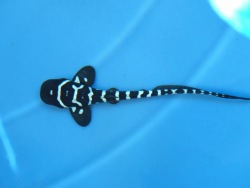Its name is Alf: the first successful breeding of zebra sharks in Russia

A zebra shark pup has hatched at the Primorsky Aquarium – it is the first captive breeding of this shark species in Russia. The hatchling weighed 100 g and measured 27 cm from the nose to the tip of the tail: the young was twice as long as the egg case, in which it had developed for six months and ten days.
“In Russia there have been cases of zebra sharks laying eggs but cases of embryos developing in them and young being born have not been reported, ours is the first one,” said Mikhail Streltsov, Head of the Tropical Marine Organisms Department. “Our female began laying eggs on February 29, the entire spawning period lasted for more than 3 months. Each egg was collected, marked and transferred to the Science and Acclimation Building for incubation. A total of 56 eggs were deposited but not all of them were fertilized and well-developed. At the early incubation stage we checked the eggs with an ultrasound scan, and later on we observed the embryo visually. We attentively monitored the yolk sac – a source of nutrients located in the egg case with an embryo - reducing in size. The moment when the yolk sac dissolved signaled that the pup was ready for external feeding, and therefore for hatching.”
The egg from which the pup emerged had been laid on March 9. The incubation lasted for a little over six months, after which the young could leave the egg case on its own. For two days there was a tiny bump – the remnant of the yolk sac – on the pup’s tummy but then it vanished. On the second day after hatching the pup started taking food by itself: during the first feeding it ate 0.4 gram of shrimps and 0.9 gram of scallops. The young has three meals a day – it is fed at nine o’clock in the morning, at one and half past four o’clock in the afternoon. Now it is given 1 to 3 grams of food. The pup is offered an extremely diverse menu: mussels, squid, scallop, shrimp, mysids, gammarids, salmon, codfish, char, smelt and capelin. The young showed food preferences almost at once: squid, scallop and gammarids became its favourites.
Zebra shark pups look strikingly unlike adult individuals. It is the juvenile coloration which gives the species its common name: their young have a distinctive pattern of black and white stripes while adults are tan with dark spots. The pup will be striped until it grows to about one meter in length, then the stripes will fade and break up into spots.
The first shark pup born at the Primorsky Aquarium was given the name Alf. It is still impossible to determine the gender of the young, and if it turns out to be a girl, she will be named Alpha.
General information:
— The Primorsky Aquarium has been home to a pair of zebra sharks (Stegostoma fasciatum) since 2018.
—Some one third of known shark species are oviparous.
—Zebra sharks are widely distributed in the warm seas of the Indian and Pacific Oceans. Their lifespan is 25-30 years.
— The zebra shark is often confused with the leopard shark. The zebra shark is distinguished by a ribbon-like caudal fin that reaches half its full body length.